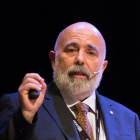
Notizie
ANNO ACCADEMICO 2024-2025
SECONDO SEMESTRE
ANTROPOLOGIA - 1019203
BIOS-03/B, 6 cfu
@ Scienze naturali (triennale)
Lunedì e martedì, ore 16:00 - 18:00
Inizio: lunedì 3 marzo 2025
Modulo di COMUNICAZIONE IN MEDICINA - 10595360
RAPPRESENTAZIONE CULTURALE DEL CORPO DELLA SALUTE E DELLA MALATTIA
BIOS-03/B, 1 cfu
@ Medicina e Chirurgia HT (magistrale a ciclo unico)
Venerdì, ore 8:00 - 10:00
Inizio: venerdì 4 aprile 2025
PRIMO SEMESTRE
EVOLUZIONE UMANA - 1041387
BIOS-03/B (ex BIO/08), 6 cfu
@ Scienze della Natura (magistrale), mutuato per Ecobiologia (magistrale)
Auletta 2, Edificio Antropologia (cu026) - 1° piano, accesso laterale dietro Aula Sergi
Lunedì e martedì ore 16:00 - 18:00
Inizio: lunedì 30 settembre 2024
ANTROPOLOGIA FISICA - 1023812
BIOS-03/B (ex BIO/08), 6 cfu
@ Scienze Archeologiche (triennale)
Auletta 2, Edificio Antropologia (cu026) - 1° piano, accesso laterale dietro Aula Sergi
Giovedì e venerdì ore 16:00 - 18:00
Inizio: giovedì 3 ottobre 2024
Modulo di METODOLOGIA MEDICO SCIENTIFICA DI BASE - 10596072
ANTROPOLOGIA
BIOS-03/B (ex BIO/08), 1 cfu
@ Medicina e Chirurgia E, Polo Pontino (magistrale a ciclo unico)
A Latina - mercoledì 27 novembre, 4 e 11 dicembre 2024 ore 9:30 - 13:30
---
ANNO ACCADEMICO 2023-2024
SECONDO SEMESTRE
ECOLOGIA UMANA E STORIA NATURALE DEI PRIMATI - 1023620
BIO/08, 6 cfu
@ Ecobiologia (magistrale), mutuato per Scienze della Natura (magistrale)
ANTROPOLOGIA - 1019203
BIO/08, 6 cfu
@ Scienze naturali (triennale)
ANTROPOLOGIA
Modulo di ANTROPOLOGIA ED EPIDEMIOLOGIA APPLICATE ALLE SCIENZE GASTRONOMICHE - 10612196
BIO/08, 7 cfu
@ Scienze, culture e politiche gastronomiche per il benessere (triennale)
ANTROPOLOGIA
Modulo di METODOLOGIA MEDICO SCIENTIFICA DI BASE II - 10606482
BIO/08, 1 cfu
@ Medicina e Chirurgia C (magistrale a ciclo unico)
RAPPRESENTAZIONE CULTURALE DEL CORPO DELLA SALUTE E DELLA MALATTIA
Modulo di COMUNICAZIONE IN MEDICINA - 10595360
BIO/08, 1 cfu
@ Medicina e Chirurgia HT (magistrale a ciclo unico)
PRIMO SEMESTRE
EVOLUZIONE UMANA - 1041387
BIO/08, 6 cfu
@ Scienze della Natura (magistrale), mutuato per Ecobiologia (magistrale)
ANTROPOLOGIA FISICA - 1023812
BIO/08, 6 cfu
@ Scienze Archeologiche (triennale)
Modulo di CULTURA E MEMORIA - 10612129
EVOLUZIONE UMANA E COMPORTAMENTO ALIMENTARE
BIO/08, 3 cfu
@ Management delle scienze gastronomiche (magistrale)
Modulo di METODOLOGIA MEDICO SCIENTIFICA DI BASE - 10596072
ANTROPOLOGIA
BIO/08, 1 cfu
@ Medicina e Chirurgia E, Polo Pontino (magistrale a ciclo unico)
PALEONTOLOGIA UMANA
BIO/08, 5 cfu
@ Scuola di specializzazione in Beni Archeologici
Orari di ricevimento
Dal Lunedì al Venerdì, in qualunque orario tra le 9:30 e le 17:30, previa prenotazione via email o telefono
From Monday to Friday, at any time between 9:30 a.m. and 5:30 p.m. by appointment (email, tel.)
Insegnamenti
| Codice insegnamento | Insegnamento | Anno | Semestre | Lingua | Corso | Codice corso | Curriculum |
|---|---|---|---|---|---|---|---|
| 10595360 | COMUNICAZIONE IN MEDICINA - RAPPRESENTAZIONE CULTURALE DEL CORPO DELLA SALUTE E DELLA MALATTIA | 1º | 2º | ITA | Medicina e chirurgia HT | 33562 | Curriculum unico |
| 1020262 | PALEOANTROPOLOGIA | 1º | 1º | ITA | Scienze e Didattica dei Sistemi Naturali - Sciences and Teaching of Natural Systems | 33608 | Clima ambiente ed energia - Percorso valido anche per coloro che partecipano al percorso internazionale di titolo multiplo italo-svizzero-svedese-francese con prima iscrizione presso l'Università di Stoccolma) |
| 10612314 | ANTROPOLOGIA E STORIA NATURALE | 3º | N/D | ITA | Scienze Archeologiche | 33521 | Archeologia orientale |
| 10616473 | PALEOANTROPOLOGIA E BIOARCHEOLOGIA | 2º | N/D | ITA | Archeologia | 33540 | Archeologia preistorica e protostorica |
| 1020262 | PALEOANTROPOLOGIA | 1º | 1º | ITA | Scienze e Didattica dei Sistemi Naturali - Sciences and Teaching of Natural Systems | 33608 | Evoluzione conservazione e didattica |
| 10616473 | PALEOANTROPOLOGIA E BIOARCHEOLOGIA | 1º | N/D | ITA | Archeologia | 33540 | Archeologia preistorica e protostorica |
| 1041387 | EVOLUZIONE UMANA | 2º | 1º | ITA | Scienze e Didattica dei Sistemi Naturali - Sciences and Teaching of Natural Systems | 33608 | Curriculum unico |
| 10616473 | PALEOANTROPOLOGIA E BIOARCHEOLOGIA | 1º | N/D | ITA | Archeologia | 33540 | Archeologia preistorica e protostorica |
| 10622125 | METODOLOGIA MEDICO SCIENTIFICA DI BASE - METODOLOGIA MEDICO SCIENTIFICA DI BASE - ANTROPOLOGIA | 1º | 2º | ITA | Medicina e chirurgia "E" - Polo Pontino | 33453 | Curriculum unico |
| 10612314 | ANTROPOLOGIA E STORIA NATURALE | 3º | N/D | ITA | Scienze Archeologiche | 33521 | Archeologia preistorica, classica, medievale |
